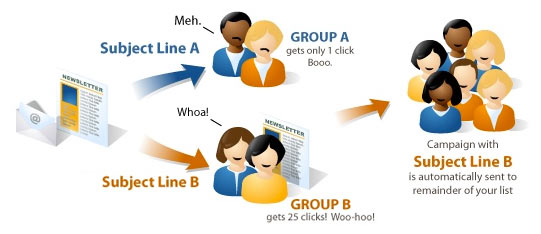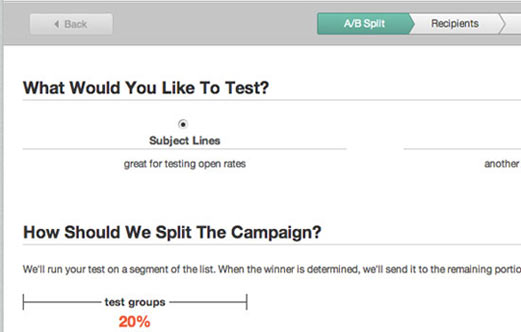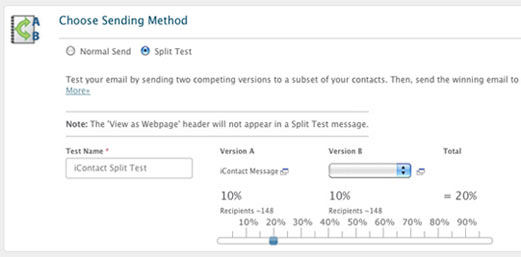How to improve your email marketing results with split testing
Split testing, which is also known as A/B testing, can be one of the most powerful tools to help you get better results from your email marketing campaigns. This technique can also be used for designing advertisements and other marketing purposes, but in this article I’m going to focus on the benefits to email marketers.
A typical beginner’s mistake with email marketing is to proceed by trial and error. This is not the same thing as split testing, as it can take you months before you realize what is and isn’t working. The main benefit of an A/B type test is that it gives you rapid feedback on a certain metric, such as your subject line, body of the message or even the time of your mailing. Let’s look at what split testing is and how you can use it in your email marketing to get better open rates and conversions.
Ways split testing can be used in email
Split testing simply means measuring one version of something against another. In reality, you will end up doing this over and over again. However, you only measure two variables for any given test.

Some of the things that can be tested in this manner with email marketing include:
- The time you send out your emails and the day of the week.
- The type of salutation you use (e.g. First Name, Full Name).
- Subject line.
- Length of message.
- Type of links in the body of the message.
- “From” field (can be your name or your business name).
- Fonts, colors and images.
- Landing page and opt-in form.
For each of these, you can test your email’s open rate and click through rate. Over time, this will reduce your cost-per-click and improve your conversions.
When conducting A/B tests, don’t forget about the importance of the opt-in form and landing page. This can have a big impact on how many subscribers you get. Test different features of the opt-in form, such as the fonts you use, the type of graphic and so forth. Naturally, you will also want to test factors such as the offer -e.g. what you are offering in exchange for people’s email addresses.
Split testing vs guessing
The main advantage of split testing is that it takes the guesswork out of email and other types of marketing. Many marketers, even experienced ones, have certain opinions and assumptions about what will and won’t work. This may be based on experience, but it can just as easily be based on personal preferences. Your prospects and customers may not share your particular perspective!
It’s fine to test something that you believe in, but if you simply assume that it’s best you may be misjudging your audience. For the most part, your readers will not tell you when they don’t like something. They will simply stop reading or responding to your emails.
For example, if you are accustomed to sending out your newsletter on Monday morning every week, you might try sending it out on Wednesday and see which gives you a better open rate. Sometimes even a small change can lead to significant improvements in results.
Every audience is different
Another thing to keep in mind is that every email list is different. For example, the day of the week that’s best to send out your emails will vary according to the demographics of your recipients. College students, office workers, full time marketers and retirees all have different schedules. That’s why you can’t believe general statements such as “It’s always best to mail on Tuesday” or anything similar.
Similarly, the approach you use in your emails will vary from one niche or demographic to another. Again, you want to test as many variables as possible. This even includes “facts” that you think you know about your audience.
Some subscribers, for instance, have a higher tolerance for hype than others. So for one list it might be appropriate to use subject lines that are strong on time sensitivity and even use words like “urgent”. This same approach will turn off other recipients. It’s best to test as many approaches as possible so you can fine-tune every aspect of your email campaigns.
Tools for split testing
There are many good tools available that make split testing easier. Some of these are provided by email marketing companies.
-
MailChimp
MailChimp, for example, has an AB Split Testing Tool that makes it easy to test the subject lines, “from” names and delivery date and time. They will send you a report that gives you the results of any tests you conduct.

-
iContact
iContact is another email marketing company that provides split testing tools, depending on the level of account you have with them.

Similarly, you will find instructions on how to conduct split tests if you subscribe to Aweber, Get Response or many other leading autoresponders.
The fact is, however, that you can do simple split testing on your own with the help of free tools such as Google Analytics. With Google Analytics you can set up an “Email Marketing Dashboard” that provides you with information such as how many visitors came to your website from an email.
Conclusion
If you want to succeed in email marketing, you cannot afford to ignore split testing. This is what separates the pros from the newbies. It’s what allows you to gradually improve the performance of your campaigns.
Split testing is something you are never really finished with. You can always test a new approach. Remember, what works today may not work as well tomorrow as other marketers copy it or people get bored with it. That’s why you should continue to split test for as long as you are engaged in email marketing!

